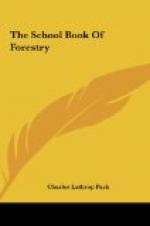In 1799 Congress set aside $200,000 for the purchase of a small forest reserve to be used as a supply source of ship timbers for the Navy. About twenty-five years later, it gave the President the power to call upon the Army and Navy whenever necessary to protect the live oak and red cedar timber so selected in Florida. In 1827, the Government started its first work in forestry. It was an attempt to raise live oak in the Southern States to provide ship timbers for the Navy. Forty years later, the Wisconsin State Legislature began to investigate the destruction of the forests of that state in order to protect them and prolong their life. Michigan and Maine, in turn, followed suit. These were some of the first steps taken to study our forests and protect them against possible extinction.
The purpose of the Timber Culture Act passed by Congress in 1873 was to increase national interest in reforestation. It provided that every settler who would plant and maintain 40 acres of timber in the treeless sections should be entitled to secure patent for 160 acres of the public domain—that vast territory consisting of all the states and territories west of the Mississippi, except Texas, as well as Ohio, Indiana, Illinois, Michigan, Wisconsin, Florida, Alabama and Mississippi. This act, as well as several State laws, failed because the settlers did not know enough about tree planting. The laws also were not effective because they did not prevent dishonest practices.
In 1876, the first special agent in forestry was appointed by the Commissioner of Agriculture to study the annual consumption, exportation and importation of timber and other forest products, the probable supply for future wants, and the means best adapted for forest preservation. Five years later, the Division of Forestry was organized as a branch of the Department of Agriculture. It was established in order to carry on investigations about forestry and how to preserve our trees.
[Illustration: Cutting mature trees and leaving seed trees to insure A second crop]
For some nine years the Division of Forestry was nothing more than a department of information. It distributed technical facts and figures about the management of private woodlands and collected data concerning our forest resources. It did not manage any of the Government timberlands because there were no forest reserves at that time. It was not until 1891 that the first forest reserve, the Yellowstone Park Timberland Reserve, was created by special proclamation of President Harrison. Later it became part of the National Park reserves. Although the Division of Forestry had no special powers to oversee and direct the management of the forest reserves, during the next six years a total of 40,000,000 acres of valuable timberland were so designated and set aside. At the request of the Secretary of the Interior, the National Academy of Sciences therefore worked out a basis for laws governing national forests. Congress enacted this law in 1897. Thereafter the Department of the Interior had active charge of the timberlands. At that time little was known scientifically about the American forests. There were no schools of forestry in this country. During the period 1898-1903, several such schools were established.




